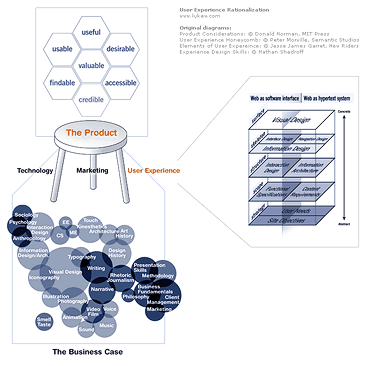In the spirit of convergence, the user experience diagram rationalization brings together the goals, processes, and disciplines that are responsible for great products. It also draws on the diagrammatic work of two information architects, one experience designer, and a cantankerous visionary.
Don Norman’s Three Legs of Human-Centered Product Development At a high-level, Norman’s “stool” diagram identifies the four primary components of successful products: “the foundation of a solid business case with three supporting legs: technology, marketing, and user experience.” Technology ensures the required functions and performance are delivered at a reasonable cost. Marketing makes certain the features included are those that customers require and that the product is positively positioned in the marketplace. A solid business case ensures the product is “providing the required attributes for a price that is acceptable to the consumers but that still yields a profit to the company.”
Jesse James Garrett’s Elements of User Experience The terms and concepts that make up the user experience component of Norman’s system are outlined in Garrett’s tiered representation. These are the tasks and considerations that create a solid user experience focused on the “needs, abilities, and thought processes of the users.”
Nathan Shedroff’s New Methods for Designing Experiences Defining products more broadly as “experiences” outlines the need for a broad set of multi-disciplinary expertise in the product development process. The convergence of these skills needs to be appropriately integrated to balance the three legs of Norman’s stool.
Peter Morville’s User Experience Honeycomb A product’s success often depends on how it fulfills basic metrics. Is it usable, Desirable? Accessible? Peter Morville’s faceted user experience honeycomb outlines the key success metrics that should serve as the goals of product development teams.
